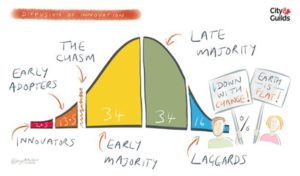The Complexity of Changing Outcomes for Students). But there is also internal change that teachers and administrators embark on, to create better learning conditions for their students. Internal change efforts are not any easier to accomplish, even though the impetus comes from within. In part this is due to how any faculty reacts to change. While not a new idea, I found this bell curve illustration of how innovation occurs to be particularly useful to the discussion of achieving positive change.
 The graphic speaks to where we direct our efforts when embarking on an innovation or change initiative that promises better results than we are now achieving. There is often a tendency to try to enlist those who are unlikely to change, and with whom we will invest a lot of energy with little to no immediate return. Our rationale is that those least likely to change are in most need of change. However, experience tells us that the innovators and early adopters are those most likely to embrace new ways of thinking about teaching and learning, as well as new technologies and approaches. The 16% of the faculty they represent (going back to the bell curve statistics and graphic) become the standard-bearers for their peers, and their successes at implementing new practices will influence the rest of the faculty. This idea was also advanced with great effect by the late Phillip Schlechty, in a number of his books including Shaking up the Schoolhouse: How to Support and Foster Educational Change (2001 Jossey Bass Publishers). Schlechty often used the metaphor of the pioneers, settlers, fence sitters, etc. but the idea is much the same: as a school leader you want to focus your efforts and support on those teachers willing to take risks to improve learning conditions for their students. With their success comes a willingness of the early majority to engage in the change effort, eventually building critical mass.
The graphic speaks to where we direct our efforts when embarking on an innovation or change initiative that promises better results than we are now achieving. There is often a tendency to try to enlist those who are unlikely to change, and with whom we will invest a lot of energy with little to no immediate return. Our rationale is that those least likely to change are in most need of change. However, experience tells us that the innovators and early adopters are those most likely to embrace new ways of thinking about teaching and learning, as well as new technologies and approaches. The 16% of the faculty they represent (going back to the bell curve statistics and graphic) become the standard-bearers for their peers, and their successes at implementing new practices will influence the rest of the faculty. This idea was also advanced with great effect by the late Phillip Schlechty, in a number of his books including Shaking up the Schoolhouse: How to Support and Foster Educational Change (2001 Jossey Bass Publishers). Schlechty often used the metaphor of the pioneers, settlers, fence sitters, etc. but the idea is much the same: as a school leader you want to focus your efforts and support on those teachers willing to take risks to improve learning conditions for their students. With their success comes a willingness of the early majority to engage in the change effort, eventually building critical mass.
